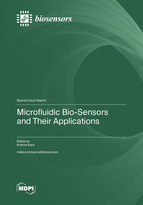Microfluidic Bio-Sensors and Their Applications
A special issue of Biosensors (ISSN 2079-6374). This special issue belongs to the section "Biosensor and Bioelectronic Devices".
Deadline for manuscript submissions: closed (10 December 2022) | Viewed by 34628
Special Issue Editor
Interests: microfluidic sensing; electrochemical bio-sensing; point-of-care diagnostics; precision diagnostics; plasmonic sensing; microfluidic devices; lab-on-chip
Special Issues, Collections and Topics in MDPI journals
Special Issue Information
Dear Colleagues,
The integration of microfluidics and sensing technology is a rapidly developing field with major applications towards diagnostic devices, including rapid detection for food safety, chemical and biological research, medical diagnostics, and environmental monitoring. This Special Issue is dedicated to covering innovations over a variety of topics in this area, from sensing to manufacturing and integration methods to novel microfluidic-based sensors for biological application. Articles reporting on the latest developments in multiplexed sensors and other types of sensor integrated with microfluidics are of interest, including electrochemical, optical, magnetic, and other transduction types.
I am very pleased to invite you to contribute to this Special Issue on “Microfluidic Bio-Sensors and Their Applications”, which are emerging research subjects with various applications. The scope of the journal is wide on biosensing, including but not limited to the following areas:
- Lab-on-a-chip and other biochips and microarray systems;
- Novel microfluidic based biosensing concepts, mechanisms, and detection principles;
- 3D printed microfluidic and biosensing devices;
- Development of biosensor methodologies and applications;
- Fabrication technology of chip-based detection devices;
- Scaffold based biomimetic systems and microfluidic devices for biosensing application;
- Biological and chemical actuators, including smart materials and microfluidic components;
- Biophotonic sensors and chemical sensing systems.
Research articles and detailed comprehensive review reports on recent development in the field as well as achievements and new fabrication technologies claimed to be relevant to biosensing and actuation will be considered for publication. This Special Issue is addressed at biologists, microfluidic experts, 3D bio printing and cell culture experts, etc.
Dr. Krishna Kant
Guest Editor
Manuscript Submission Information
Manuscripts should be submitted online at www.mdpi.com by registering and logging in to this website. Once you are registered, click here to go to the submission form. Manuscripts can be submitted until the deadline. All submissions that pass pre-check are peer-reviewed. Accepted papers will be published continuously in the journal (as soon as accepted) and will be listed together on the special issue website. Research articles, review articles as well as short communications are invited. For planned papers, a title and short abstract (about 100 words) can be sent to the Editorial Office for announcement on this website.
Submitted manuscripts should not have been published previously, nor be under consideration for publication elsewhere (except conference proceedings papers). All manuscripts are thoroughly refereed through a single-blind peer-review process. A guide for authors and other relevant information for submission of manuscripts is available on the Instructions for Authors page. Biosensors is an international peer-reviewed open access monthly journal published by MDPI.
Please visit the Instructions for Authors page before submitting a manuscript. The Article Processing Charge (APC) for publication in this open access journal is 2700 CHF (Swiss Francs). Submitted papers should be well formatted and use good English. Authors may use MDPI's English editing service prior to publication or during author revisions.
Keywords
- Point-of-care (PoC)
- Diagnostics
- Molecular imprinted polymer biosensing
- Multiplexed biosensing
- Bio-inspired materials
- Cell and tissue sensors
- 3D printing
- Microfluidic devices
- Lab-on-chip







